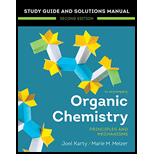
Organic Chemistry: Principles And Mechanisms: Study Guide/solutions Manual (second)
2nd Edition
ISBN: 9780393655551
Author: KARTY, Joel
Publisher: W. W. Norton & Company
expand_more
expand_more
format_list_bulleted
Concept explainers
Question
Chapter 2, Problem 2.4P
Interpretation Introduction
Interpretation:
The incorrect representation in the given wedge-dash notation is to be identified, explained, and corrected.
Concept introduction:
Wedge-dash notation is used to represent the three dimensional structure of a molecule. A straight line stands for bonds in the plane of the paper. A wedge bond stands for a bond coming out of the paper, toward the observer. A dash represents a bond going into the plane of the paper, away from the observer. Generally, the atom or group at the thinner end of either bond is in the plane of the paper.
Expert Solution & Answer
Want to see the full answer?
Check out a sample textbook solution
Students have asked these similar questions
Instructions: Complete the questions in the space provided. Show all your work
1. You are trying to determine the rate law expression for a reaction that you are completing at 25°C. You measure
the initial reaction rate and the starting concentrations of the reactions for 4 trials.
BrO³¯ (aq) + 5Br¯ (aq) + 6H* (aq) → 3Br₂ (l) + 3H2O (l)
Initial rate
Trial
[BrO3]
[H*]
[Br]
(mol/L)
(mol/L) | (mol/L)
(mol/L.s)
1
0.10
0.10
0.10
8.0
2
0.20
0.10
0.10
16
3
0.10
0.20
0.10
16
4
0.10
0.10
0.20
32
a.
Based on the above data what is the rate law expression?
b. Solve for the value of k (make sure to include proper units)
2. The proposed reaction mechanism is as follows:
i.
ii.
BrО¸¯ (aq) + H+ (aq) → HBrO3 (aq)
HBrO³ (aq) + H* (aq) → H₂BrO3* (aq)
iii.
H₂BrO³* (aq) + Br¯ (aq) → Br₂O₂ (aq) + H2O (l)
[Fast]
[Medium]
[Slow]
iv.
Br₂O₂ (aq) + 4H*(aq) + 4Br(aq) → 3Br₂ (l) + H2O (l)
[Fast]
Evaluate the validity of this proposed reaction. Justify your answer.
е.
Д
CH3
D*, D20
C.
NaOMe,
Br
Br
Chapter 2 Solutions
Organic Chemistry: Principles And Mechanisms: Study Guide/solutions Manual (second)
Ch. 2 - Prob. 2.1PCh. 2 - Prob. 2.2PCh. 2 - Prob. 2.3PCh. 2 - Prob. 2.4PCh. 2 - Prob. 2.5PCh. 2 - Prob. 2.6PCh. 2 - Prob. 2.7PCh. 2 - Prob. 2.8PCh. 2 - Prob. 2.9PCh. 2 - Prob. 2.10P
Ch. 2 - Prob. 2.11PCh. 2 - Prob. 2.12PCh. 2 - Prob. 2.13PCh. 2 - Prob. 2.14PCh. 2 - Prob. 2.15PCh. 2 - Prob. 2.16PCh. 2 - Prob. 2.17PCh. 2 - Prob. 2.18PCh. 2 - Prob. 2.19PCh. 2 - Prob. 2.20PCh. 2 - Prob. 2.21PCh. 2 - Prob. 2.22PCh. 2 - Prob. 2.23PCh. 2 - Prob. 2.24PCh. 2 - Prob. 2.25PCh. 2 - Prob. 2.26PCh. 2 - Prob. 2.27PCh. 2 - Prob. 2.28PCh. 2 - Prob. 2.29PCh. 2 - Prob. 2.30PCh. 2 - Prob. 2.31PCh. 2 - Prob. 2.32PCh. 2 - Prob. 2.33PCh. 2 - Prob. 2.34PCh. 2 - Prob. 2.35PCh. 2 - Prob. 2.36PCh. 2 - Prob. 2.37PCh. 2 - Prob. 2.38PCh. 2 - Prob. 2.39PCh. 2 - Prob. 2.40PCh. 2 - Prob. 2.41PCh. 2 - Prob. 2.42PCh. 2 - Prob. 2.43PCh. 2 - Prob. 2.44PCh. 2 - Prob. 2.45PCh. 2 - Prob. 2.46PCh. 2 - Prob. 2.47PCh. 2 - Prob. 2.48PCh. 2 - Prob. 2.49PCh. 2 - Prob. 2.50PCh. 2 - Prob. 2.51PCh. 2 - Prob. 2.52PCh. 2 - Prob. 2.53PCh. 2 - Prob. 2.54PCh. 2 - Prob. 2.55PCh. 2 - Prob. 2.56PCh. 2 - Prob. 2.57PCh. 2 - Prob. 2.58PCh. 2 - Prob. 2.59PCh. 2 - Prob. 2.60PCh. 2 - Prob. 2.61PCh. 2 - Prob. 2.62PCh. 2 - Prob. 2.63PCh. 2 - Prob. 2.64PCh. 2 - Prob. 2.65PCh. 2 - Prob. 2.66PCh. 2 - Prob. 2.67PCh. 2 - Prob. 2.68PCh. 2 - Prob. 2.69PCh. 2 - Prob. 2.70PCh. 2 - Prob. 2.71PCh. 2 - Prob. 2.72PCh. 2 - Prob. 2.1YTCh. 2 - Prob. 2.2YTCh. 2 - Prob. 2.3YTCh. 2 - Prob. 2.4YTCh. 2 - Prob. 2.5YTCh. 2 - Prob. 2.6YTCh. 2 - Prob. 2.7YTCh. 2 - Prob. 2.8YTCh. 2 - Prob. 2.9YTCh. 2 - Prob. 2.10YTCh. 2 - Prob. 2.11YTCh. 2 - Prob. 2.12YTCh. 2 - Prob. 2.13YTCh. 2 - Prob. 2.14YTCh. 2 - Prob. 2.15YTCh. 2 - Prob. 2.16YTCh. 2 - Prob. 2.17YTCh. 2 - Prob. 2.18YTCh. 2 - Prob. 2.19YTCh. 2 - Prob. 2.20YT
Knowledge Booster
Learn more about
Need a deep-dive on the concept behind this application? Look no further. Learn more about this topic, chemistry and related others by exploring similar questions and additional content below.Similar questions
- Please predict the products for each of the following reactions: 1.03 2. H₂O NaNH, 1. n-BuLi 2. Mel A H₂ 10 9 0 H2SO4, H₂O HgSO4 Pd or Pt (catalyst) B 9 2 n-BuLi ♡ D2 (deuterium) Lindlar's Catalyst 1. NaNH2 2. EtBr Na, ND3 (deuterium) 2. H₂O2, NaOH 1. (Sia)2BH с Darrow_forwardin the scope of ontario SCH4U grade 12 course, please show ALL workarrow_forwardIs the chemical reaction CuCl42-(green) + 4H2O <==> Cu(H2O)42+(blue) + 4Cl- exothermic or endothermic?arrow_forward
- If we react tetraethoxypropane with hydrazine, what is the product obtained (explain its formula). State the reason why the corresponding dialdehyde is not used.arrow_forwarddrawing, no aiarrow_forwardIf CH3COCH2CH(OCH3)2 (4,4-dimethoxy-2-butanone) and hydrazine react, two isomeric products are formed. State their structure and which will be the majority.arrow_forward
- + Reset Provide the correct IUPAC name for the compound shown here. 4-methylhept-2-ene (Z)- (E)- 1-6-5-2-3-4- cyclo iso tert- sec- di tri hept hex oct meth eth pent ane yne ene ylarrow_forward+ Provide the correct IUPAC name for the compound shown here. Reset H3C H H C CH3 CH-CH3 1-3-methylpent ene trans- cis- 5-6-3-1-2-4- tert- tri sec- di cyclo iso but pent hex meth prop eth yl ane ene yne ☑arrow_forwarddrawing, no aiarrow_forward
arrow_back_ios
SEE MORE QUESTIONS
arrow_forward_ios
Recommended textbooks for you
 Organic Chemistry: A Guided InquiryChemistryISBN:9780618974122Author:Andrei StraumanisPublisher:Cengage Learning
Organic Chemistry: A Guided InquiryChemistryISBN:9780618974122Author:Andrei StraumanisPublisher:Cengage Learning

Organic Chemistry: A Guided Inquiry
Chemistry
ISBN:9780618974122
Author:Andrei Straumanis
Publisher:Cengage Learning